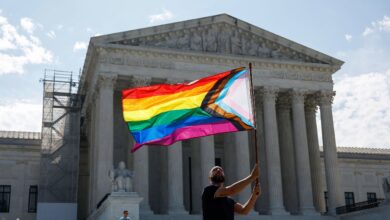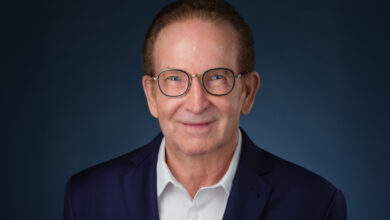Why There is No Such Thing as “Gay Marriage”
Language matters in the fight for true equality.
Today marks the tenth anniversary of Obergefell v. Hodges. On June 26, 2015, James Obergefell stood on the Supreme Court steps, having just witnessed the Court declare that the fundamental right to marry extends to all couples, regardless of gender. In that moment of triumph, the named plaintiff expressed a hope that might surprise many: “Today’s ruling from the Supreme Court affirms what millions across the country already know to be true in our hearts: that our love is equal.” Then he added: “It is my hope that the term gay marriage will soon be a thing of the past, that from this day forward it will be, simply, marriage.”1
A decade later, as we commemorate this watershed moment in constitutional law, Obergefell’s prescient words deserve renewed attention.

The Constitutional Foundation: Marriage is Marriage
The Supreme Court’s holding in Obergefell v. Hodges rested on a fundamental principle: there is only one institution of marriage under the Constitution. The Court didn’t create a new category of union or establish separate-but-equal marriage rights. Instead, it recognized that “the reasons marriage is fundamental under the Constitution apply with equal force to same-sex couples.”
Justice Kennedy’s majority opinion identified four principles that make marriage a fundamental right: personal autonomy in intimate decisions, the unique importance of the two-person union, safeguarding of children and families, and marriage as a keystone of social order. Crucially, the Court found these principles applied identically to all couples seeking to marry.
The constitutional analysis turned on whether excluding certain couples from marriage violated the Fourteenth Amendment’s guarantees of due process and equal protection. The Court concluded such exclusions did violate these guarantees, requiring states to extend marriage—the same marriage available to different-sex couples—to same-sex couples. Notice the language: the Court consistently used “marriage,” not “same-sex marriage” or “gay marriage.” This wasn’t accidental.
The decision established that states must “license a marriage between two people of the same sex and recognize a marriage between two people of the same sex when their marriage was lawfully licensed and performed out-of-state.” The Court treated marriage as a single institution with universal requirements and benefits.
The Human Stakes Behind Constitutional Principles
The abstract constitutional principles at stake in Obergefell took concrete form in James Obergefell and John Arthur’s twenty-one-year love story. When the Supreme Court handed down United States v. Windsor on June 26, 2013, striking down the Defense of Marriage Act, Jim stood beside John’s bed holding his hand as they watched the coverage together. John Arthur was dying of ALS, confined to bed and requiring full-time care from the man who had become his devoted caregiver. In that moment, Jim realized that “this was the first time in our almost 21 years together that we could get married and actually have it mean something, at least to the federal government.”2 He leaned over, kissed John on the head, and said “Let’s get married.” John said yes.
Their wedding five days later demonstrated the extraordinary lengths couples went to for legal recognition before Obergefell. Since Ohio prohibited same-sex marriage, friends and family raised over $13,000 to charter a medical jet to Baltimore, where Maryland had legalized such unions. On July 11, 2013, their plane remained on the tarmac at Baltimore-Washington International Airport for only 56 minutes, with the ceremony lasting just 7½ minutes. John, despite his weakened condition, managed to speak his vows and exchange rings. When the brief ceremony concluded, Jim reflected: “There was something magical about that short ceremony. We felt better. We felt different. We felt more complete. It truly was the happiest moment of our many years together.”3
The constitutional violation became starkly apparent just five days after their wedding when civil rights attorney Al Gerhardstein showed them a blank Ohio death certificate. He pointed to where John would be listed as “single” with no surviving spouse recorded. “John and I knew Ohio wouldn’t recognize our marriage, but that was abstract,” Jim later recalled. “This death certificate made that abstract understanding into something real, something harmful, something hurtful.”4 Ohio recognized other out-of-state marriages that couldn’t be performed in-state—such as first-cousin marriages—but refused to recognize same-sex marriages performed elsewhere. The Equal Protection violation was unmistakable.
Their federal lawsuit, filed eight days after their wedding, sought recognition of their Maryland marriage on John’s eventual death certificate. When John Arthur died on October 22, 2013—exactly three months and eleven days after their airport ceremony—his death certificate properly listed him as married to James Obergefell due to a court order from U.S. District Judge Timothy Black. Jim’s decision to continue the case after John’s death reflected a simple principle: “John deserved to die a married man. We simply wanted dignity.”5 Their fight for that dignity ultimately transformed constitutional law for every couple in America.
The Fundamental Problem with “Same-Sex Marriage” and “Gay Marriage”
When media coverage, legal briefs, and everyday conversation consistently use terms like “same-sex marriage” or “gay marriage,” we accept the premise that gender composition creates meaningful distinctions between marriages. But Obergefell held the opposite—that gender-based exclusions from marriage violate constitutional principles precisely because marriage is marriage, regardless of the couple’s gender.
Consider the parallel to Loving v. Virginia, which struck down bans on interracial marriage in 1967. We don’t routinely refer to unions between people of different races as “interracial marriages” as if they constitute a separate category. They’re simply marriages. The same principle applies post-Obergefell: all legally recognized unions between two people are marriages, regardless of gender.
This isn’t merely semantic wordplay. Language shapes understanding, and understanding shapes acceptance. From a legal standpoint, precision in terminology reflects accuracy in constitutional analysis. Obergefell held that excluding same-sex couples from marriage violated their fundamental right to marry, not their right to “same-sex marriage.”
The constitutional violation lay in denying access to marriage itself. If courts and advocates consistently frame the issue as involving a separate category of marriage, future challenges can more easily argue that Obergefell created special rights rather than extending universal ones.
Why “Marriage Equality” Captures the Truth
The term “marriage equality” accurately captures both the legal reality and the movement’s goal. Rather than suggesting different types of marriage, it emphasizes equal access to the existing institution of marriage.
“Marriage equality” focuses on the principle at stake: equal treatment under law. It encompasses both the right to marry and the recognition of existing marriages—the two issues Obergefell addressed. Most importantly, it avoids creating linguistic hierarchies that suggest some marriages matter more than others.
This terminology also reflects the constitutional framework. The Equal Protection Clause demands equal treatment, not separate institutions. When we discuss “marriage equality,” we describe the legal landscape as it actually exists post-Obergefell: one institution of marriage, available to all qualified couples regardless of gender.
The precision matters strategically. Language that reinforces the singular nature of marriage strengthens rather than undermines legal protections. Each time we say “marriage equality” instead of “same-sex marriage,” we reinforce the constitutional principle that marriage is marriage.
Real-World Consequences of Language Choices
These linguistic choices have practical implications beyond legal theory. When advocacy organizations consistently use “same-sex marriage” in fundraising appeals, they inadvertently suggest they’re fighting for something separate from “regular” marriage. When news outlets default to “gay marriage” in headlines, they reinforce the notion that some marriages are modified versions of others.
The consequences extend to policy discussions. State legislatures considering recognition issues frame debates differently when discussing “marriage equality” versus “same-sex marriage recognition.” The former emphasizes extending existing benefits; the latter suggests creating new categories.
Even in everyday conversations, the terminology matters. When couples describe their own relationships, referring to their “marriage” rather than their “same-sex marriage” or “gay marriage” reinforces their equal standing. Language that treats all marriages as simply marriages helps normalize full equality.
The Path Forward: Lessons from a Decade
Ten years after Obergefell, James Obergefell’s hope that marriage would “from this day forward” be “simply, marriage” reflects both legal reality and aspirational equality. The Supreme Court recognized marriage as a single institution with universal significance. Our language should reflect that reality.
This anniversary offers an opportunity to assess both progress and persistent challenges. While Obergefell established constitutional protection for marriage equality, recent developments demonstrate that legal victories require ongoing vigilance to maintain. Precise language becomes part of that vigilance.
This isn’t about political correctness—it’s about accuracy. Obergefell v. Hodges didn’t create “same-sex marriage” or “gay marriage.” The Court recognized that the Constitution requires equal access to marriage—the same marriage that has always existed, now available to all couples who seek its “fulfillment for themselves.”
The stakes extend beyond terminology. Language shapes perception, and perception influences both public support and legal vulnerability. As this tenth anniversary coincides with renewed challenges to marriage equality, using precise language that reflects constitutional reality strengthens the foundation Obergefell established.
As Obergefell himself understood, true equality means marriage is simply marriage. A decade later, as we commemorate this constitutional milestone, our language should continue reflecting that principle: there is no such thing as “gay marriage” or “same-sex marriage”—there is only marriage, available to all couples who choose to make that commitment to each other.
Marriage is marriage, period.
1 Supreme Court Rules Gay Couples Nationwide Have a Right to Marry, WASH. POST, June 26, 2015, https://www.washingtonpost.com/politics/gay-marriage-and-other-major-rulings-at-the-supreme-court/2015/06/25/ef75a120-1b6d-11e5-bd7f-4611a60dd8e5_story.html.
2 James Obergefell, interview (2015) (on file with author). See also JAMES OBERGEFELL & DEBBIE CENZIPER, LOVE WINS: THE LOVERS AND LAWYERS WHO FOUGHT THE LANDMARK CASE FOR MARRIAGE EQUALITY
3 Id.
4 Id.
5 James Obergefell, NPR Interview (2015); see also OBERGEFELL & CENZIPER, supra note 2.
This piece originally appeared on Substack










